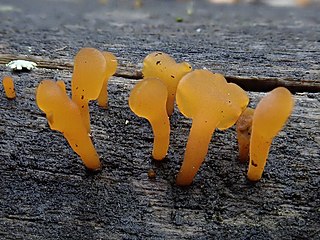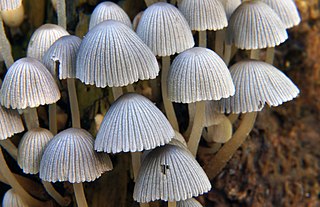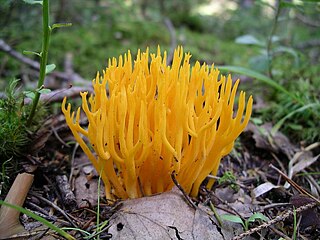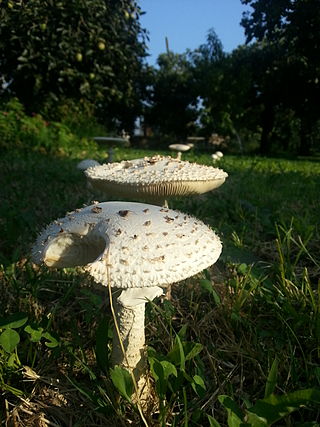
Malassezia is a genus of fungi. It is the sole genus in family Malasseziaceae, which is the only family in order Malasseziales, itself the single member of class Malasseziomycetes. Malassezia species are naturally found on the skin surfaces of many animals, including humans. In occasional opportunistic infections, some species can cause hypopigmentation or hyperpigmentation on the trunk and other locations in humans. Allergy tests for these fungi are available.

Eurotiomycetes is a large class of ascomycetes with cleistothecial ascocarps within the subphylum Pezizomycotina, currently containing around 3810 species according to the Catalogue of Life. It is the third largest lichenized class, with more than 1200 lichen species that are mostly bitunicate in the formation of asci. It contains most of the fungi previously known morphologically as "Plectomycetes".

The Hypocreales are an order of fungi within the class Sordariomycetes. In 2008, it was estimated that it contained some 237 genera, and 2647 species in seven families. Since then, a considerable number of further taxa have been identified, including an additional family, the Stachybotryaceae. Wijayawardene et al. in 2020 added more families and genera to the order. According to the Catalog of Life, As of April 2021 the Hypocreales contains 6 families, 137 genera, and 1411 species.

Persoonia, commonly known as geebungs or snottygobbles, is a genus of about one hundred species of flowering plants in the family Proteaceae. Plants in the genus Persoonia are shrubs or small trees usually with smooth bark, simple leaves and usually yellow flowers arranged along a raceme, each flower with a leaf or scale leaf at the base. The fruit is a drupe.

Helotiales is an order of the class Leotiomycetes within the division Ascomycota. The taxonomy within Helotiales has been debated. It has expanded significantly as genomic techniques for taxonomical identification have become more commonly used. As of February 2020, the order is estimated to contain 30 accepted families, 519 genera, and 6266 species.

Dacryopinax spathularia is a species of fungus in the family Dacrymycetaceae. Basidiocarps are gelatinous, frequently spathulate (spoon-shaped), and grow on wood, mainly in the tropics and subtropics. The fungus is edible and is commercially cultivated for use as an additive in the food industry.
In phylogenetics, basal is the direction of the base of a rooted phylogenetic tree or cladogram. The term may be more strictly applied only to nodes adjacent to the root, or more loosely applied to nodes regarded as being close to the root. Note that extant taxa that lie on branches connecting directly to the root are not more closely related to the root than any other extant taxa.

The Agaricomycotina is one of three subdivisions of the Basidiomycota. The Agaricomycotina contains over 30000 species, divided into 4 classes. Around 98% of species are in the class Agaricomycetes including all the agarics, bracket fungi, clavarioid fungi, corticioid fungi, and gasteroid fungi. The Tremellomycetes contain many basidiomycetous yeasts and some conspicuous jelly fungi. The Dacrymycetes contain a further group of jelly fungi, while the Bartheletiomycetes comprise a single anomalous species on fallen leaves of Ginkgo biloba. All these taxa are founded on molecular research, based on cladistic analysis of DNA sequences, and supersede earlier morphology-based classifications.

The Dacrymycetaceae are a family of fungi in the order Dacrymycetales. Species are saprotrophs and occur on dead wood. Their distribution is worldwide. Basidiocarps are ceraceous to gelatinous, often yellow to orange, and variously clavarioid, disc-shaped, cushion-shaped, spathulate, or corticioid (effused).

The Dacrymycetes are a class of fungi in the Basidiomycota. The class currently contains the single order Dacrymycetales, with a second proposed order Unilacrymales now treated at the family level. The order contains four families and has a cosmopolitan distribution.

Geoglossaceae is a family of fungi in the order Geoglossales, class Geoglossomycetes. These fungi are broadly known as earth tongues. The ascocarps of most species in the family Geoglossaceae are terrestrial and are generally small, dark in color, and club-shaped with a height of 2–8 cm. The ascospores are typically light-brown to dark-brown and are often multiseptate. Other species of fungi have been known to parasitize ascocarps. The use of a compound microscope is needed for accurate identification.

Persoonia linearis, commonly known as the narrow-leaved geebung, is a shrub native to New South Wales and Victoria in eastern Australia. It reaches 3 m (9.8 ft), or occasionally 5 m (16 ft), in height and has thick, dark grey papery bark. The leaves are, as the species name suggests, more or less linear in shape, and are up to 9 cm (3.5 in) long, and 0.1 to 0.7 cm wide. The small yellow flowers appear in summer, autumn and early winter, followed by small green fleshy fruit known as drupes. Within the genus Persoonia, it is a member of the Lanceolata group of 58 closely related species. P. linearis interbreeds with several other species where they grow together.

Persoonia lanceolata, commonly known as lance-leaf geebung, is a shrub native to New South Wales in eastern Australia. It reaches 3 m (10 ft) in height and has smooth grey bark and bright green foliage. Its small yellow flowers grow on racemes and appear in the austral summer and autumn, followed by green fleshy fruits which ripen the following spring. Within the genus Persoonia, P. lanceolata belongs to the lanceolata group of 58 closely related species. It interbreeds with several other species found in its range.
Cerinomyces is a genus of fungi in the order Dacrymycetales. Species are saprotrophs and occur on dead wood. As originally conceived, the genus comprised species of the Dacrymycetes having effused, corticioid basidiocarps. Molecular research, based on cladistic analysis of DNA sequences, has however shown that this circumscription is not valid. As a result, the genus now contains some species having corticioid basidiocarps and some additional species with gelatinous, pustular basidiocarps. Around 30 species have been described worldwide.

Dacrymyces is a genus of fungi in the family Dacrymycetaceae. Species are saprotrophs and occur on dead wood. Their distribution is worldwide. Basidiocarps are ceraceous to gelatinous, often yellow to orange, and typically disc-shaped to cushion-shaped.
Dacryonaema is a genus of fungi in the order Dacrymycetales. As with other members of the Dacrymycetes, species of Dacryonaema are saprotrophs, occur on dead wood, and have gelatinous basidiocarps. Microscopically all species have clamped hyphae and branched hyphidia.

Persoonia terminalis, also known as the Torrington geebung, is a shrub belonging to the family Proteaceae, and native to northern New South Wales and southern Queensland in eastern Australia. Reported as a subspecies of Persoonia nutans in 1981, it was described as a species by Lawrie Johnson and his colleague Peter Weston in 1991.

The genus Saproamanita contains about 24 species of agarics and is one of six genera in the family Amanitaceae. The others are Amanita, Catatrama, Limacellopsis, Zhuliangomyces and Limacella. Saproamanita are the saprophytic species in the Tribe Amaniteae, separately classified from the ectomycorrhizal species in the genus Amanita.
The Dacryonaemataceae are a family of fungi in the order Dacrymycetales. The family currently contains the single genus Dacryonaema with three known species from Europe and North America.
The Cerinomycetaceae are a family of fungi in the order Dacrymycetales. The family currently contains the single genus Cerinomyces which has a cosmopolitan distribution.














